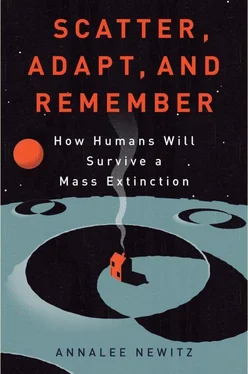Keller believes that the flows may have come so rapidly that life nearby had no chance to recover—and that the toxins and carbon released by the explosions wound up killing off creatures across the globe with environmental changes similar to those at the end of the Permian. A runaway greenhouse effect, combined with acid rain and ocean dead zones, would have made the planet unlivable for the majority of its inhabitants. “That’s the likely killing mechanism,” Keller concluded matter-of-factly.
Who is right? It’s entirely possible that both Smit and Alvarez on one side and Keller on the other have identified causes of the K-T mass extinction. There are other theories, too. A fungal spike in the fossil record during the mass extinction has led at least one scientist to suggest that the dinosaurs died of fungal infections like the ones that are causing extinctions among amphibians and bats today. When the evidence in the geological record is relatively fresh, it becomes obvious that most mass extinctions on Earth have multiple causes. And as Keller’s work suggests, evidence gathered outside Europe and the Americas can offer a new perspective on old theories. We know that the bodies start piling up when environments change, but many events all over the world may have set those changes in motion.
The Late Triassic Period (220 Million–200 Million Years Ago): The Beginning of Our World
One of the difficulties in sorting out what happened to the dinosaurs has nothing to do with geological evidence and everything to do with human culture. Dinosaurs have been so widely misrepresented in pop culture about the prehistoric world that it’s hard for us to step back and appreciate this diverse array of creatures for what they actually were, and how they really died out.
To get the real story, we’ll return to the chaotic Triassic period that followed the Great Dying, when many species evolved and died out rapidly. Late in the Triassic, about 220 million years ago, dinosaurs began to evolve. At this time, they were, as Brown University geologist Jessica Whiteside put it, “about the size of German shepherds and not very diverse.” Their main competitors were the crurotarsans, those fierce carnivores that eventually evolved into crocodiles and alligators. How did a relatively small group of mini-dinos prevail against these toothy, occasionally armored beasts? “If you were in the Triassic, you would bet on crurotarsans,” Whiteside said. But surprisingly, most crurotarsans did not survive the mass extinction that ended the Triassic, leaving the dinosaurs to take over lands once dominated by their mega-gator counterparts.
Whiteside attributes this bizarre turn of events to one of the most stupendous underwater volcanoes in Earth history. Known as the Central Atlantic magmatic province (CAMP), the eruption started about 200 million years ago in a narrow body of water separating the eastern Americas from West Africa. (At that time, the two continents were still joined into the Pangaea supercontinent.) The lava flow from CAMP was tremendous. It forced the continental plates so far apart that an entire ocean grew between once-connected regions known today as Canada and Morocco.
If this eruption could create one of Earth’s biggest oceans, just imagine the high volumes of carbon, methane, and sulfur it was pumping into the water and the atmosphere. A superhot greenhouse gripped the planet as the Triassic wound to a murky close. Whiteside ticked off the deaths that followed: As the temperatures climbed higher, the world-spanning tropical forests of the Triassic dried out and succumbed to enormous wildfires. The burned remains of forests slipped into the oceans along with carbon-rich soil. The oceans became acidic, which led to anoxia and die-offs there. Coral reefs were the first to go, and their deaths set off a cascading effect where anything that fed higher in the food chain died too. It was the perfect storm for destroying food webs, starting in the oceans and creeping up onto a warming land whose trees were being eaten by fire. Once again, climate change was killing the world.
The rise (and fall and rise) of the dinosaurs’ world
There are many well-preserved plant fossils from this era, so it’s possible to visualize how the extreme greenhouse conditions changed the environment between the Triassic and the Jurassic. Jennifer McElwain, a paleobotanist at University College Dublin, has spent years studying this transition in Greenland, excavating everything from leaves and flowers to microscopic bits of pollen, to reconstruct the world where dinosaurs ultimately triumphed. Today, coastal Greenland is hard tundra that’s too cold for trees, but in the late Triassic and early Jurassic, it was full of lush vegetation. McElwain called it “a cross between New Zealand conifers and the Florida Everglades.” It was a world of “broad, meandering rivers” and “big, wide floodplains” bordering forests full of towering trees and stubby, thick-trunked plants called cycadeoids with palmlike fronds bursting from their tops. And then came CAMP, with its carbon emissions and rising global temperatures.
Tens of thousands of years of greenhouse conditions led to fire after fire. Ultimately, McElwain believes, the environment of diverse trees, shady forests, and thick vegetation was reduced to swamps full of ferns. “There would have been ferns as far as the eye can see, with hardly any trees, and lots of fire,” McElwain said. There was no complex, multitiered canopy in the forests, so the landscape would have been much brighter. But within another 100,000 years, the region went back to being conifer-dominated. What emerges from this fast-motion vision of ancient forests rising, burning, and rising again is something approaching the truth of where the dinosaurs began. They were among the only survivors of radical environmental changes that drove their competitors to extinction. Most crurotarsans were extinguished in the burned threads of food webs, but those small, early dinosaurs were able to spread out and adapt to the new environments and continents.
When forests at last returned to the land, dinosaurs evolved to be much larger. They diversified into armored herbivores like triceratops and plate-backed stegosaurus, sneaky scavengers, and predators like the 40-foot-long T. rex that we’ve seen in movies from the 1933 version of King Kong to Jurassic Park . Dinosaurs were as diverse as mammals are today, and their behavior probably varied a great deal from species to species. Many of them walked on two legs, with body postures similar to birds—their heads would have been thrust far forward, their spines nearly horizontal, and their tails held out stiffly behind them rather than dragging on the ground. Indeed, most paleontologists today accept that birds evolved from therapods, a group of bipedal, feathered dinosaurs that included the infamous T. rex . If you ever want to imagine what it would be like to face down a dinosaur, imagine a hulking, 40-foot-long crow whose beak has become a toothy mouth.
Recent evidence suggests that many dinosaurs weren’t feathered in quite the way birds are today. Most had dark gray or reddish proto-feathers (often called dinofuzz) that looked something like spiny down. Indeed, dinosaurs may have had proto-feathers for millions of years before birds evolved the ability to fly. Also like their bird relatives, many dinosaurs made nests and laid eggs. Though it’s hard to piece together how these different Cretaceous animals might have behaved, some paleontologists theorize that they may have been social, like birds, forming flocks and possibly mating for life.
What we do know is that when the catastrophes of the Cretaceous period hit, dinosaurs were in a position similar to their old rivals, the mega-gator crurotarsans. A lot of dinosaurs had evolved into specialists, and were therefore deeply connected to food webs that were all too easy to unravel with a few shifts in global temperature. This time, a group of mouse-like, furry animals called mammals—the descendants of the Permian survivor Lystrosaurus —were the survivors.
Читать дальше






![Аннали Ньюиц - Автономность [litres]](/books/424681/annali-nyuic-avtonomnost-litres-thumb.webp)





